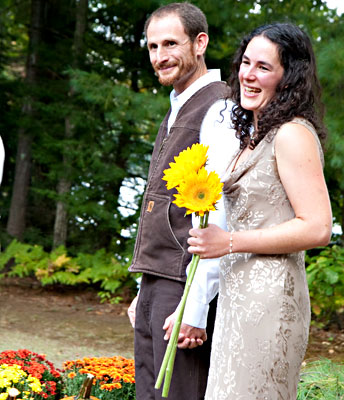 |
| Andy and Julia McLeod at their wedding. Photo courtesy of Sarah Moore. |
By Julia McLeod
I can imagine some future brides poring over wedding magazines – delighting in dresses, shoes and flowers. I pored over seed catalogs – oohing and aahing over heirloom tomatoes and watermelon varieties. My husband, Andy, and I decided to grow and cook the majority of the food for our nearly 100 wedding guests. It was an incredibly meaningful and rewarding experience, and dinner was delicious.
The idea to do it ourselves came from the fact that we love to eat, and we especially love to eat fresh, healthy, whole, real food. Naturally, when we started planning our wedding, we agreed immediately that we wanted to celebrate by sharing a delicious meal made from fresh ingredients with our friends and families. The catch is that we didn’t have a lot of money to spend on the wedding, so we knew we couldn’t afford a caterer who would cook the food we wanted. More importantly, we love doing things ourselves, and we wanted to become intimately involved in preparing for this very important day. This project also seemed like a good challenge for us to prepare for having our own farm.
Some thought we were crazy to take on such a big project ourselves – to grow and cook almost all the food for nearly 100 people. The owner of the camp we rented for the weekend seemed reluctant to let us, amateur caterers, use his kitchen; we might start a fire or break some expensive equipment. He commented that with all the things to think about on our wedding day, cooking dinner would be too much. Andy responded that there was nothing else he’d rather think about than making dinner for all his friends and family. And I can thank my parents for teaching me that anything is possible with determination and hard work.
It’s hard to explain why we get so much satisfaction from providing for our own needs. Over the last few years, we’ve cut firewood, built chicken tractors, smoked bacon and ham, knit sweaters and hats, made cheese and yogurt, brewed beer, boiled sap into maple syrup, canned many foods, and frozen many different fruits and vegetables. Partly, we do this to provide ourselves with products we can’t find or can’t afford at the grocery store, but it’s about more than that. Every log on the fire or newly opened jar of food reminds us of the intentional actions it took to warm the house or to cook dinner. We find meaning in hard work that connects us to our daily needs. I feel lucky to have found a partner who shares this love.
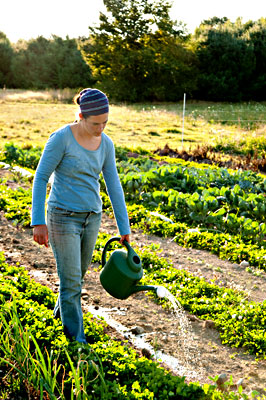 |
| Julia and Andy McLeod in the garden before their wedding, growing most of the food they served to nearly 100 guests. Photos courtesy of Sarah Moore. |
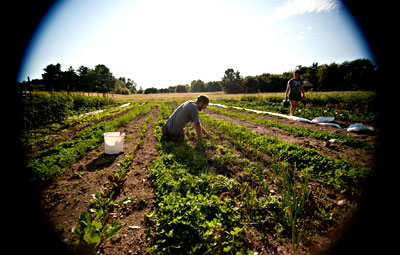 |
To document the experience of growing and preparing the food for our wedding, I wrote a blog: https://localfoodwedding.wordpress.com/.
Planning the wedding was a process of discarding our preconceived notions of what a wedding should be. In the beginning, I though we needed to hire a caterer. I though we had to rent nice dishes and tablecloths. I thought we should send out paper invitations and give all guests wedding favors. When we really started thinking and talking about what was important to us, however, we decided to keep only the traditions that have meaning to us. We realized that what we really wanted was to spend quality time with people we care about and be intimately involved in our wedding dinner, from seed to plate.
We wanted to be able to spend a good amount of time with our guests, some of whom we were asking to travel great distances to see us get married. So we started thinking about our wedding as a weekend event, rather than one afternoon or even one day. We decided to invite our closest friends and family members to come the day before the wedding to help us cook our wedding dinner with ingredients we raised. We kept the recipes simple to make it easier for everyone. We didn’t need fancy recipes. Fresh ingredients speak for themselves.
We started with a menu, and from that figured out about how much of each crop we’d need to feed around 100 guests. We decided to raise chickens, grow vegetables and fruits, and make some prepared foods such as cheese and pickles. Next, we looked around for land we could use for the summer. Luckily for us, at the time we were living at Medomak Camp in the town of Washington. The owners of the camp graciously let us till up a plot on their property to use for our garden.
They also let us keep chickens at the camp. The garage served as their nursery for the first few weeks, the peacefulness interrupted once in a while by over-excited young campers eager to hold a baby chicken. Freecycle (www.freecycle.org) provided us with scrap lumber and lawnmower wheels for our two chicken tractors. Once the birds had their true feathers, we moved them from the garage onto the lawn. Every day we would drag the tractors to a fresh patch of grass, leaving behind piles of chicken poop and spilled grain to fertilize the yard. By the time we made it all the way around the yard, the grass had recovered enough for a second pass. Despite a healthy fox population in the neighborhood, we lost zero chickens all summer.
We knew we’d need somewhere to prepare and serve a lot of food, so we started looking for a facility to rent for the whole wedding weekend. We figured that if we had access to a commercial kitchen and a walk-in cooler, we could cook everything on Friday and just heat it up on Saturday for our wedding dinner. We also wanted to provide somewhere for our guests to stay overnight so that we could spend more time with them.
Since we planned to get married in the fall, summer camps were empty, and we found the perfect one – Camp Winnebago in Fayette, not far from Augusta – on a lake and complete with kitchen and bunkhouses. We invited our friends and family to cook on Friday, and we had a great time hanging out with everyone and cooking all day. In the end, we also decided to hire two people to help in the kitchen on Saturday so that we wouldn’t have to worry about getting dinner on the table.
Working in our wedding garden (in addition to our full time jobs) was usually a lovely and relaxing way to spend evenings and weekends. Our garden was tucked away from the road, surrounded by fields and woods. As we crested a hill, the dirt road to our plot petered out and we could look down on our little square of vegetables in the midst of pasture and lowbush blueberries. Many evenings were spent kneeling in soft clover pathways pulling weeds or picking potato beetles and letting my mind wander. I always felt refreshed by doing a little work and seeing what we created. I hope I never lose the feeling of gardening as a miracle of nature.
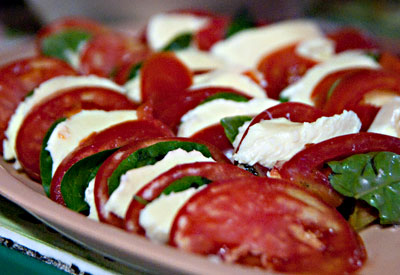 |
| Caprese salad made from tomatoes and basil that the McLeods grew and mozzarella cheese that they made. Photo courtesy of Sarah Moore. |
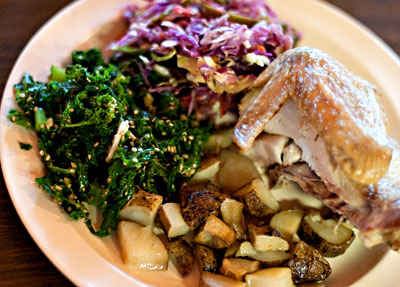 |
| The main course at the wedding included rosemary roasted chicken, roasted potatoes, maple kale salad and Swedish coleslaw. Photo courtesy of Sarah Moore. |
Of course everything did not go smoothly. As happens with farming, we had to remind ourselves throughout the process that failure is a learning experience. Our potato plants were decimated by leafhoppers (although we still got plenty of potatoes out of them), our onions never got bigger than walnuts, and the greens weren’t ready in time. At times I wondered if the whole experiment would be a failure and we’d just have to buy the food. In the end, I find it remarkable that we pulled it off. Without professional experience cooking or catering, we fed more than 90 people mostly from food we raised, grew or made from scratch. We bought a few items, but not much. We actually grew and cooked enough for three wedding dinners, but our guests didn’t seem to mind bringing home leftovers.
Our wedding project was also a test of our relationship, with the stress of not knowing how things would turn out and having to make many decisions together. We realized that we approach projects and life quite differently. I like to think things through before I start them and have a plan for exactly what steps need to take place when. When we have to stray from the plan, I’m stressed out. Andy, however, likes to figure things out as he goes along and is more flexible when things don’t go as planned.
“We’ll figure it out,” he kept telling me during the months leading up to the wedding.
“But I want to figure it out now,” I’d reply.
We struggled at times and got grumpy with each other, but we figured out some strategies for accepting and taking advantage of our differences instead of fighting them, which is a valuable lesson to learn before getting married.
In the end we had so much more than dinner. We got to share an amazing day bonding with friends and families, truly appreciating the superheroes that Moms and aunts are, and basking in the success of a well-executed plan. We shared a delicious dinner, and we filled our freezer with leftovers. Andy asked me several times during the wedding weekend: “Was it all worth it? All the hard work?” Without hesitation, my answer was yes every time. We had a wedding I will always cherish, complete with good food, good friends and the love of my life.
Julia McLeod (formerly Julia Davis) lives with her husband, Andy, on a piece of land they bought in Bowdoin. They are finishing a new house, have a baby on the way, and plan to ease into farming. They’ve picked a name for their new farm: Scratch Farm.
Our Menu
Appetizers
Veggie platter*
Homemade hummus
Cantaloupe and watermelon*
Fruit and cheese platter (including cantaloupe*, watermelon*, and homemade and donated cheese)
Caprese salad (tomatoes, basil and mozzarella cheese)*
Homemade half sour kosher dill pickles*
Chips and homemade salsa*
Dinner:
Rosemary roasted chicken*
Roasted potatoes*
Squash soup*
Maple kale salad*
Garden salad*
Swedish coleslaw*
Homemade bread
Dessert:
A variety of homemade pies (made by our mothers and aunts)
John’s ice cream from Liberty
*Made from ingredients we grew or raised
How Much to Grow?
In about 7,500 square feet, with rows about 100 feet long, we grew much more food than we served at the wedding, by design. We put away a lot for winter, in addition to feeding our wedding guests. For just the wedding, we could have planted much less.
For the wedding, we grew carrots, cucumbers, watermelon, cantaloupe, tomatoes, basil, butternut squash, onions, cabbage, bell peppers, kale, hakurei turnips, potatoes, pie pumpkins, dill and hot peppers.
We grew all the ingredients for (and made) salsa and half sour kosher dill pickles. We also made cheese.
We started with the recipes to figure out how many pounds of each ingredient we would need. (Moosewood Cooks for a Crowd is a good resource.) Then we looked up projected yields for different crops to decide how much to plant. Then we planted extra of everything, as well as a few crops we didn’t serve at the wedding, such as corn and beets.
Aside from appetizers, the recipes we used for dinner called for the following:
35 pounds butternut squash
10 pounds onions
12 pounds carrots
12 pounds cabbage
12 bell peppers
13 pounds kale
25 hakurei turnips
40 pounds potatoes
We raised 50 Freedom Ranger chickens – 17 for the wedding.
